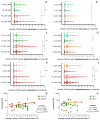Evidence of Human Parvovirus B19 Infection in the Post-Mortem Brain Tissue of the Elderly
- PMID: 30366357
- PMCID: PMC6267580
- DOI: 10.3390/v10110582
Evidence of Human Parvovirus B19 Infection in the Post-Mortem Brain Tissue of the Elderly
Abstract
After primary exposure, the human parvovirus B19 (B19V) genome may remain in the central nervous system (CNS), establishing a lifelong latency. The structural characteristics and functions of the infected cells are essential for the virus to complete its life cycle. Although B19V has been detected in the brain tissue by sequencing PCR products, little is known about its in vivo cell tropism and pathogenic potential in the CNS. To detect B19V and investigate the distribution of its target cells in the CNS, we studied brain autopsies of elderly subjects using molecular virology, and optical and electron microscopy methods. Our study detected B19V in brain tissue samples from both encephalopathy and control groups, suggesting virus persistence within the CNS throughout the host's lifetime. It appears that within the CNS, the main target of B19V is oligodendrocytes. The greatest number of B19V-positive oligodendrocytes was found in the white matter of the frontal lobe. The number was significantly lower in the gray matter of the frontal lobe (p = 0.008) and the gray and white matter of the temporal lobes (p < 0.0001). The morphological changes observed in the encephalopathy group, propose a possible B19V involvement in the demyelination process.
Keywords: PCR; elderly; electron microscopy; glia; immunohistochemistry; parvovirus B19.
Conflict of interest statement
The authors declare no conflict of interest.
Figures






Similar articles
-
Recent Advances in Replication and Infection of Human Parvovirus B19.Front Cell Infect Microbiol. 2018 Jun 5;8:166. doi: 10.3389/fcimb.2018.00166. eCollection 2018. Front Cell Infect Microbiol. 2018. PMID: 29922597 Free PMC article. Review.
-
Low-level DNAemia of parvovirus B19 (genotypes 1-3) in adult transplant recipients is not associated with anaemia.J Clin Virol. 2013 Oct;58(2):443-8. doi: 10.1016/j.jcv.2013.07.007. Epub 2013 Jul 31. J Clin Virol. 2013. PMID: 23916377
-
Impact of Parvovirus B19 Viremia in Liver Transplanted Children on Anemia: A Retrospective Study.Viruses. 2017 Jun 13;9(6):149. doi: 10.3390/v9060149. Viruses. 2017. PMID: 28608818 Free PMC article.
-
Prevalence of parvovirus B19 and human bocavirus DNA in the heart of patients with no evidence of dilated cardiomyopathy or myocarditis.Clin Infect Dis. 2009 Dec 1;49(11):1660-6. doi: 10.1086/648074. Clin Infect Dis. 2009. PMID: 19863443
-
Persistent parvovirus B19 infection in non-erythroid tissues: possible role in the inflammatory and disease process.Virus Res. 2014 Sep 22;190:8-16. doi: 10.1016/j.virusres.2014.06.017. Epub 2014 Jul 3. Virus Res. 2014. PMID: 24998884 Review.
Cited by
-
The Role of the p16 and p53 Tumor Suppressor Proteins and Viral HPV16 E6 and E7 Oncoproteins in the Assessment of Survival in Patients with Head and Neck Cancers Associated with Human Papillomavirus Infections.Cancers (Basel). 2023 May 11;15(10):2722. doi: 10.3390/cancers15102722. Cancers (Basel). 2023. PMID: 37345059 Free PMC article.
-
Neurological Impact of Respiratory Viruses: Insights into Glial Cell Responses in the Central Nervous System.Microorganisms. 2024 Aug 20;12(8):1713. doi: 10.3390/microorganisms12081713. Microorganisms. 2024. PMID: 39203555 Free PMC article. Review.
-
Is the ZIKV Congenital Syndrome and Microcephaly Due to Syndemism with Latent Virus Coinfection?Viruses. 2021 Apr 13;13(4):669. doi: 10.3390/v13040669. Viruses. 2021. PMID: 33924398 Free PMC article. Review.
-
Identification of High-Risk Human Papillomavirus DNA, p16, and E6/E7 Oncoproteins in Laryngeal and Hypopharyngeal Squamous Cell Carcinomas.Viruses. 2021 May 27;13(6):1008. doi: 10.3390/v13061008. Viruses. 2021. PMID: 34072187 Free PMC article.
-
Identification and Genomic Characterization of Parvovirus B19V Genotype 3 Viruses from Cases of Meningoencephalitis in West Bengal, India.Microbiol Spectr. 2022 Apr 27;10(2):e0225121. doi: 10.1128/spectrum.02251-21. Epub 2022 Apr 12. Microbiol Spectr. 2022. PMID: 35412386 Free PMC article.
References
-
- Hokynar K., Norja P., Hedman K., Söderlund-Venermo M. Tissue Persistence and Prevalence of B19 Virus Types 1-3. Future Virol. 2007;2:377–388. doi: 10.2217/17460794.2.4.377. - DOI
MeSH terms
Substances
LinkOut - more resources
Full Text Sources

